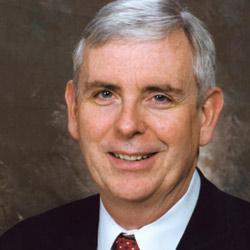
It’s easy to think of places like Mayo Clinic or Cleveland Clinic when there’s mention of cutting-edge medical treatments and technology. But healthcare in central Illinois can hold its own against these and other well-known medical giants.
An example is Dr. James Williams. This cardiovascular and thoracic surgeon has dedicated the bulk of his professional life to treating the people of central Illinois, with a special interest in minimally invasive treatments of the arterial system, while distinguishing himself in the medical community, both locally and nationwide. For the last 10 years, Dr. Williams has partnered with Methodist Medical Center in an innovative endografting program that has helped save the lives of hundreds of area patients.
 An endograft is a covered stent that offers a minimally invasive way to treat diseases of the aorta. The aorta is the largest artery in the body, originating from the left ventricle of the heart extending down to the abdomen, where it branches off into two smaller arteries. The aorta brings oxygenated blood to all parts of the body. Dr. Williams, with over 600 completed procedures, is widely recognized as a leader in his field. He has been involved in six Food and Drug Administration (FDA) approved device trials over the years, giving the area access to a new, breakthrough technology.
An endograft is a covered stent that offers a minimally invasive way to treat diseases of the aorta. The aorta is the largest artery in the body, originating from the left ventricle of the heart extending down to the abdomen, where it branches off into two smaller arteries. The aorta brings oxygenated blood to all parts of the body. Dr. Williams, with over 600 completed procedures, is widely recognized as a leader in his field. He has been involved in six Food and Drug Administration (FDA) approved device trials over the years, giving the area access to a new, breakthrough technology.
Dr. Williams is particularly proud of the fellowship training he has developed for surgeons from around the country. So far, 16 different surgeons have completed the fellowship program known as Endovascular Therapies Fellowship Training (etft.org). “This fellowship offers a truly unique curriculum for practicing surgeons,” explained Williams. “Physicians come here for six weeks. They do very intensive study and have access to FDA-required teaching. It’s truly a mentoring process.” Dr. Williams said these techniques are not really offered in the university setting and that was a primary reason for developing the fellowship. Between six and eight surgeons complete the fellowship each year.
This February, Dr. Williams speaks before an international heart conference sponsored by the Arizona Heart Institute. His reputation and work at Methodist have drawn numerous speaking requests around the county. “Methodist, over the years, has really made a big commitment to give us the resources to develop and expand our work in endovascular surgery,” said Williams.
Williams stresses that for the patient, endovascular procedures offer significant advantages, including a minimally invasive procedure versus a full-blown surgery, fewer complications, shorter hospital stays and greatly improved mortality outcomes, especially for the treatment of ruptured aneurysms.
For the patient receiving a stent, follow-up treatment usually requires three CT scans the first year—at one month, six months and 12 months. After the first year, only a single CT scan is necessary each year to insure that the aorta is healing properly, the graft is not moving and that there are no leaks surrounding the graft.
Since his first case in January 2000, Dr. Williams recognized the endograft as a significant medical treatment making it possible to treat more and sicker people. His philosophy of medicine is simple—treat the patient as if he or she is family. Treating about 1,000 people a year, Dr. Williams has made a positive impact with his patients, his community and his profession. iBi

